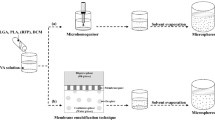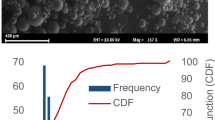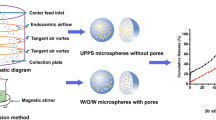Abstract
Purpose
The acidic microclimate pH (µpH) distribution inside poly(lactic-co-glycolic acid) (PLGA) microspheres was monitored quantitatively as a function of several formulation variables.
Methods
A ratiometric method by confocal laser scanning microscopy with Lysosensor yellow/blue® dextran was adapted from those previously reported, and µpH distribution kinetics inside microspheres was examined during incubation under physiologic conditions for 4 weeks. Effects of PLGA molecular weight (MW) and lactic/glycolic acid ratio, microspheres size and preparation method, and polymer blending with poly(ethylene glycol) (PEG) were evaluated.
Results
µpH kinetics was accurately sensed over a broadly acidic range (2.8 < µpH < 5.8) and was more acidic and variable inside PLGA with lower MW and lactic/glycolic acid ratio. Lower µpH was found in larger microspheres of lower MW polymers, but size effects for lactic-rich polymers were insignificant during 4 weeks. Microspheres prepared by the oil-in-oil emulsion method were less acidic than those prepared by double emulsion, and blending PLGA 50/50 with 20% PEG increased µpH significantly (µpH > 5 throughout incubation).
Conclusions
Coupling this method with that previously developed (SNARF-1® dextran for µpH 5.8–8.0) should provide microclimate pH mapping over the entire useful pH range (2.8–8.0) for optimization of PLGA delivery of pH-sensitive bioactive substances.










Similar content being viewed by others

References
S. P. Schwendeman. Recent advances in the stabilization of proteins encapsulated in injectable PLGA delivery systems. Crit. Rev. Ther. Drug Carrier Sys. 19:73–98 (2002).
S. P. Schwendeman, H. R. Costantino, R. K. Gupta, and R. Langer. Peptide, protein, and vaccine delivery from implantable polymeric systems. Progress and challenges. In K. Park (ed.), Controlled Drug Delivery, American Chemical Society, Washington, D. C., 1997, pp. 229–267.
R. Langer, and J. P. Vacanti. Tissue engineering. Science. 260:920–926 (1993).
R. Langer. Controlled release of a therapeutic protein. Nat. Med. 2:742–743 (1996).
E. Mathiowitz, J. Jacob, Y. Jong, G. Carino, D. Chickering, P. Chaturvedi, C. Santos, K. Vijayaraghavan, S. Montgomery, M. Bassett, and C. Morrell. Biological erodable microspheres as potential oral delivery systems. Nature. 386:410–414 (1997).
O. L. Johnson, J. L. Cleland, H. J. Lee, M. Charnis, E. Duenas, W. Jaworowicz, D. Shepard, A. Shahzamani, A. J. Jones, and S. D. Putney. A month-long effect from a single injection of microencapsulated human growth hormone. Nat. Med. 2:795–799 (1996).
H. Okada, and H. Toguchi. Biodegradable microspheres in drug delivery. Crit. Rev. Ther. Drug Carrier Sys. 12:1–99 (1995).
H. Okada. One- and three-month release injectable microspheres of the LH-RH superagonist leuprorelin acetate. Adv. Drug Del. Rev. 28:43–70 (1997).
K. Fu, A. M. Klibanov, and R. Langer. Protein stability in controlled-release systems. Nat Biotechnol. 18:24–25 (2000).
S. D. Putney, and P. A. Burke. Improved protein therapeutics with sustained-release formulations. Nat. Biotechnol. 16:478 (1998).
S. D. Putney, and P. A. Burke. Improved protein therapeutic with sustained-release formulations. Nat. Biotechnol. 16:153–157 (1998).
M. Stern, K. Ulrich, D. M. Geddes, and E. W. F. W. Alton. Poly (D, L-lactic-co-glycolic acid)/DNA microspheres to facilitate prolonged transgene expression in airway epithelium in vitro, ex vivo and in vivo. Gene Therapy. 10:1282–1288 (2003).
A. Shenderova, T. G. Burke, and S. P. Schwendeman. The acidic microclimate in poly(lactic-co-glycolic acid) microspheres stabilizes camptothecins. Pharm. Res. 16:241–248 (1999).
T. G. Park. Degradation of poly(lactic-co-glycolic acid) microspheres: effect of copolymer composition. Biomaterials. 16:1123–1130 (1995).
T. Uchida, A. Yagi, Y. Oda, Y. Nakada, and S. Goto. Instability of bovine insulin in poly(lactic-co-glycolic acid) (PLGA) microspheres. Chem. Pharm. Bull. 44:235–236 (1996).
G. Zhu, S. R. Mallery, and S. P. Schwendeman. Stabilization of proteins encapsulated in injectable poly(lactic-co-glycolic acid). Nat. Biotechnol. 18:52–57 (2000).
W. Jiang, and S. P. Schwendeman. Stabilization of tetanus toxoid encapsulated in PLGA microspheres. Molec. Pharmaceutics, in press.
J. Kang, and S. P. Schwendeman. Comparison of the effects of Mg(OH)2 and sucrose on the stability of bovine serum albumin encapsulated in poly(D,L-lactic-co-glycolic acid) implants. Biomaterials. 23:239–245 (2002).
P. A. Burke. Determination of internal pH in PLGA microspheres using 31P NMR spectroscopy. Proc. Int. Symp. Control. Release Bioact. Mater. 23:133–134 (1996).
A. Brunner, K. Mader, and A. Göpferich. pH and osmotic pressure inside biodegradable microspheres during erosion. Pharm. Res. 16:847–853 (1999).
A. Shenderova, A. G. Ding, and S. P. Schwendeman. Potentiometric method for determination of microclimate pH in poly(lactic-co-glycolic) films. Macromolecules. 37:10052–10058 (2004).
K. Fu, D. W. Pack, A. M. Klibanov, and R. Langer. Visual evidence of acidic environment within degrading poly(lactic-co-glycolic acid) (PLGA) microspheres. Pharm. Res. 17:100–106 (2000).
L. Li, and S. P. Schwendeman. Mapping meutral microclimate pH in PLGA microspheres. J. Control. Rel. 101:163–173 (2005).
H. Okada, Y. Doken, Y. Ogawa, and H. Toguchi. Preparation of three-month depot injectable microspheres of leuprorelin acetate using biodegradable polymers. Pharm. Res. 11:1143–1147 (1994).
J. W. McGinity, and P. B. O’Donnell. Preparation of microspheres by the solvent evaporation technique. Adv. Drug Del. Rev. 28:25–42 (1997).
F. Boury, H. Marchais, J. E. Proust, and J. P. Benoit. Bovine serum albumin release from poly(.alpha.-hydroxy acid) microspheres: effects of polymer molecular weight and surface properties. J. Control. Rel. 45:75–86 (1997).
W. Jiang, and S. P. Schwendeman. Stabilization of a model formalinized protein antigen encapsulated in poly(lactic-co-glycolic acid)-based microspheres. J. Pharm. Sci. 90:1558–1569 (2001).
W. Jiang, and S. P. Schwendeman. Stabilization and controlled release of bovine serum albumin encapsulated in poly(D, L-lactic) and poly(ethylene glycol) microsphere blends. Pharm. Res. 18:878–885 (2001).
D. Perrin, and B. Dempsey. Buffers for pH and metal ion control. Halsted Press, New York, N. Y., 1979.
J. Kang, and S. P. Schwendeman. Determination of diffusion coefficient of a small hydrophobic probe in poly(lactic-co-glycolic acid) microparticles by laser scanning confocal microscopy. Macromolecules. 36:1324–1330 (2003).
A. G. Ding, A. Shenderova, and S. P. Schwendeman. Prediction of microclimate pH in poly(lactic-co-glycolic acid) films. J. Am. Chem. Soc. 128:5384–5390 (2006).
A. G. Ding, and S. P. Schwendeman. Determination of water-soluble acid distribution in poly(lactic-co-glycolic acid). J. Pharm. Sci. 93:322–331 (2004).
M. A. Tracy, K. L. Ward, L. Firouzabadian, Y. Wang, N. Dong, R. Qian, and Y. Zhang. Factors affecting the degradation rate of poly(lactic-co-glycolic acid) microspheres in vivo and in vitro. Biomaterials. 20:1057–1062 (1999).
G. Zhu. Stabilization and controlled release of proteins encapsulated in poly(lactic-glycolic acid) delivery systems, Ph.D. thesis, The Ohio State University, 1999.
A. G. Ding. Mechanistic evaluation of acidic microclimate pH development in biodegradable poly (lactic-co-glycolic acid) delivery systems, Ph.D thesis, University of Michigan, 2005.
J. Kang, and S. P. Schwendeman. Pore closing and opening in biodegradable polymers and their effect on the controlled release of proteins. Mol. Pharm. 4:104–118 (2007).
F. G. Hutchinson, and B. J. A. Furr. Biodegradable polymer systems for the sustained release of polypeptides. J. Control. Release. 13:279–294 (1990).
E. C. Lavelle, M. K. Yeh, A. G. A. Coombes, and S. S. Davis. The stability and immunogenicity of a protein antigen encapsulated in biodegradable microparticles based on blends of lactide polymers and polyethylene glycol. Vaccine. 17:512–529 (1999).
Acknowledgements
This work was supported by NIH HL 68345 and a Univ. of Michigan Barbour Fellowship to A.G. Ding.
Author information
Authors and Affiliations
Corresponding author
Rights and permissions
About this article
Cite this article
Ding, A.G., Schwendeman, S.P. Acidic Microclimate pH Distribution in PLGA Microspheres Monitored by Confocal Laser Scanning Microscopy. Pharm Res 25, 2041–2052 (2008). https://doi.org/10.1007/s11095-008-9594-3
Received:
Accepted:
Published:
Issue Date:
DOI: https://doi.org/10.1007/s11095-008-9594-3



